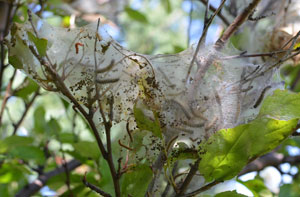 The webworm is a common pest of trees in Texas. It attacks more than 88 different kinds of plants,but does not attack conifers (pines and other needle-bearing trees). Webworms are known for the large webs they produce. Heavy infestations are rarely fatal, but if they occur repeatedly over several years they can stress trees and make them more susceptible to drought, disease or other insect pests which can be fatal. The feeding preferences of webworms vary from one place to another. In west Texas, mulberry, poplar and willow are preferred; oak, hickory and pecan are most often attacked in east Texas. While Pecans are favored in the other parts of Texas.
The webworm is a common pest of trees in Texas. It attacks more than 88 different kinds of plants,but does not attack conifers (pines and other needle-bearing trees). Webworms are known for the large webs they produce. Heavy infestations are rarely fatal, but if they occur repeatedly over several years they can stress trees and make them more susceptible to drought, disease or other insect pests which can be fatal. The feeding preferences of webworms vary from one place to another. In west Texas, mulberry, poplar and willow are preferred; oak, hickory and pecan are most often attacked in east Texas. While Pecans are favored in the other parts of Texas.
There are two to four generations of webworms each year in Texas. Four generations occur in southern portions of the state, while two to three generations occur in the northern areas. The first generation occurs as early as April in south Texas and as late as June around Lubbock and Amarillo. The last generation of the year, which occurs in the fall, is usually the most damaging and gives the insect its name.
The mass of webbing spun by fall webworms is known as a nest. Each nest can contain hundreds of webworms. The webworm caterpillars within a nest all hatched from the same mass of eggs laid by a female fall webworm moth. The caterpillars feed together for several weeks, expanding the web as needed. Nests can expand to three feet across or more. Fall webworms feed within their nest until they reach full size, at which time they crawl out of the nest, and usually away from the tree, to form a cocoon. Caterpillars from one nest will not crawl to other trees to form new nests.
If you suspect that you have a trees suffering from a fall webworm infestation or another infection, call L & A Tree Service at 903-357-9292 or contact us now for assistance.
